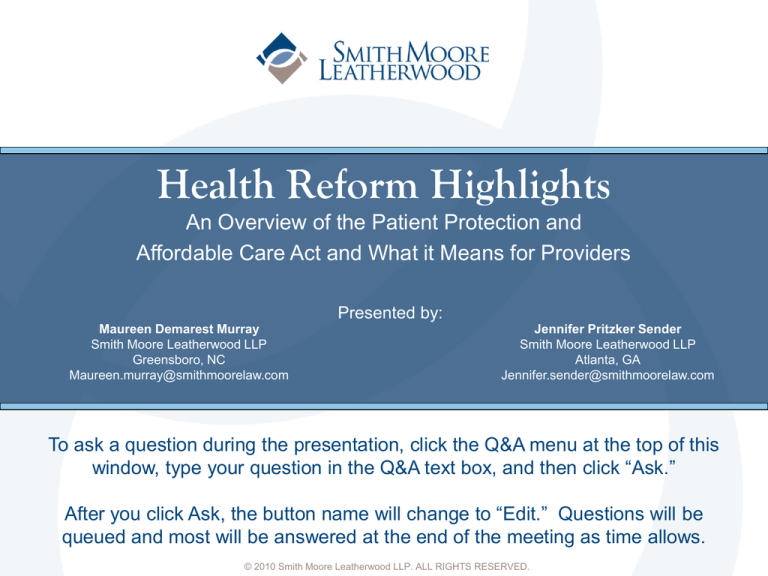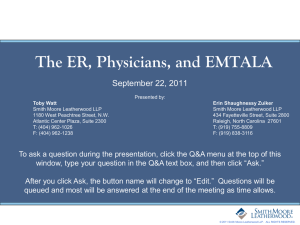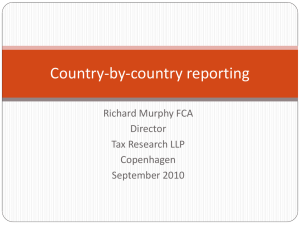
Health Reform Highlights
An Overview of the Patient Protection and
Affordable Care Act and What it Means for Providers
Presented by:
Maureen Demarest Murray
Smith Moore Leatherwood LLP
Greensboro, NC
Maureen.murray@smithmoorelaw.com
Jennifer Pritzker Sender
Smith Moore Leatherwood LLP
Atlanta, GA
Jennifer.sender@smithmoorelaw.com
To ask a question during the presentation, click the Q&A menu at the top of this
window, type your question in the Q&A text box, and then click “Ask.”
After you click Ask, the button name will change to “Edit.” Questions will be
queued and most will be answered at the end of the meeting as time allows.
© 2010 Smith Moore Leatherwood LLP. ALL RIGHTS RESERVED.
Introduction
• Sunday, March 21, 2010 – House passed the Senate health care
reform bill, H.R. 3590 “Patient Protection and Affordable Care Act”
(PPACA)
• House passed the reconciliation bill, H.R. 4872 “Health Care and
Education Reconciliation Act” on Sunday, March 21, 2010
• The President signed PPACA into law on March 23, 2010 with the
stroke of a pen (actually 22 pens)
• The President signed H.R. 4872 into law on March 30, 2010 (at
NoVA Community College)
© 2010 Smith Moore Leatherwood LLP. ALL RIGHTS RESERVED.
Introduction
• According to the Congressional
Budget Office (CBO), the cost of
health reform is $938 billion over the
next decade
• Through increases in taxes and
Medicare payment cuts, it is projected
the deficit will be reduced by $143
billion
• Reform affects 32 million uninsured
Americans, and all aspects of the
health system (especially providers)
© 2010 Smith Moore Leatherwood LLP. ALL RIGHTS RESERVED.
Introduction
Regulatory Guidance needs to be issued regarding:
– Affordable health insurance coverage options
– Definitions of essential health benefits
– Dependents staying on parents’ insurance
© 2010 Smith Moore Leatherwood LLP. ALL RIGHTS RESERVED.
Introduction
What is health care reform supposed to accomplish?
– Access to affordable health coverage
– Improving the quality and delivery of care
– Curbing growth of health care costs
© 2010 Smith Moore Leatherwood LLP. ALL RIGHTS RESERVED.
Main Themes
Three Main Themes of PPACA
Coverage Expansion
– Title I
Affordable Health Care – Private Coverage Expansion
– Title II
Public Programs – Medicaid, SCHIP, DSH,
Prescription Coverage
© 2010 Smith Moore Leatherwood LLP. ALL RIGHTS RESERVED.
Main Themes
Quality Improvement/Cost Efficiency
– Title III
Improving the Quality and Efficiency of Health Care
– Title IV
Prevention of Chronic Disease and Improving Public
Health
– Title V
Health Care Workforce
– Title VI
Transparency and Program Integrity
– Title VII Improving Access to Innovative Medical Therapies
© 2010 Smith Moore Leatherwood LLP. ALL RIGHTS RESERVED.
Main Themes
Raising Revenue
– Title VIII Community Living Assistance Services and Supports
– Title IX
Revenues Provisions – Excise Tax on High-Cost Insurance Plans
– Title X
Changes/Additions to the Preceding 9 Titles
© 2010 Smith Moore Leatherwood LLP. ALL RIGHTS RESERVED.
Main Themes
New Reform Entities
• Center of Innovation
• Independent Payment Advisory Board
• Patient Centered Outcomes Research Institute
• Coordinated Health Care Office
© 2010 Smith Moore Leatherwood LLP. ALL RIGHTS RESERVED.
Main Themes
To be discussed in later webinars:
– Insurance Reforms
– Health Insurance Exchange
– Individual & Employer Responsibility
– Tax Provisions
© 2010 Smith Moore Leatherwood LLP. ALL RIGHTS RESERVED.
Effect on Providers
(What does this mean for providers?)
Hospitals
– Market basket update reductions
between 2010 – 2019
– Increased payments to hospitals
in counties in the lowest quartile of
per capita Medicare spending,
effective 2011
– Reduced payments to hospitals
with high readmission rates,
effective fiscal year 2013
– Reduced payments to hospitals
for hospital acquired conditions,
effective fiscal year 2015
Smith Moore Leatherwood LLP
© 2010 Smith Moore Leatherwood LLP. ALL RIGHTS RESERVED.
Effect on Providers
(What does this mean for providers?)
Imaging
– Utilization rate assumption from 50% - 75%, effective 2011
– Reduction for imaging procedures on contiguous body parts
– Physicians must disclose ownership interests in imaging
equipment and provide a list of local suppliers (effective now)
LTCH
– Market basket update reduced
Smith Moore Leatherwood LLP
© 2010 Smith Moore Leatherwood LLP. ALL RIGHTS RESERVED.
Accountable Care Organizations
– Allows groups of providers who meet certain
statutory criteria to be recognized as ACO's
and be eligible to share in the cost-savings
achieved by the Medicare program
• Promotes accountability and coordination of Parts A & B
• Joint decision making (group practices, networks of
practices, partnerships, jvs)
• Brookings-Dartmouth, Carilion Clinic, Community Care of NC
(formation stage)
• To be discussed in later Webinar
Smith Moore Leatherwood LLP
© 2010 Smith Moore Leatherwood LLP. ALL RIGHTS RESERVED.
Effect on Providers
(What does this mean for providers?)
Medical Home – Grants to fund medical home models
– Geisinger Health System – team-based, provider & payor
– Medicaid enrollees with chronic health conditions could designate a
provider as a medical home
– Bundled payments – Effective 2013, HHS required to develop a
national voluntary bundled payment pilot program to provide incentives
for providers to coordinate care
Primary Care – 10% bonus payments for certain primary care
services and general surgeons providing care in HPSA's, effective
2011-2016
Smith Moore Leatherwood LLP
© 2010 Smith Moore Leatherwood LLP. ALL RIGHTS RESERVED.
Quality & Transparency
– Nursing Homes
• Public disclosure of ownership
• Implementation of compliance and staff training
• Enhanced CMP's
– Physician Payments
• Effective 2013 – public reporting of payments made by drug
and device manufacturers to physicians
– Quality Measures/Reporting
– Value-Based Purchasing
Smith Moore Leatherwood LLP
© 2010 Smith Moore Leatherwood LLP. ALL RIGHTS RESERVED.
Fraud and Abuse
Title VI – not a lot of press, but most immediate changes for providers
– Limitations on Physician Ownership in Hospitals
• PPACA prohibits physician ownership in hospitals unless
both the physician-ownerships in place, and the hospital has
a Medicare provider agreement prior to December 31, 2010
• Such grandfathered hospitals may continue to participate in
Medicare under tighter restrictions addressing conflict of
interest, bona fide investments, patient safety, and expansion
limitations
• After date of enactment, a physician-owned ASC cannot be
converted to a hospital
Smith Moore Leatherwood LLP
© 2010 Smith Moore Leatherwood LLP. ALL RIGHTS RESERVED.
Fraud and Abuse
• Hospitals must have procedures in place for
owners to disclose physician ownership to patients
and the public
• Physician-owned hospitals must submit an annual
report to the Secretary of DHHS containing all
owner/investors and the nature/extent of the
ownership/investments
• Limited expansion may be applied for once every
two years (maximum increase of 100%)
Smith Moore Leatherwood LLP
© 2010 Smith Moore Leatherwood LLP. ALL RIGHTS RESERVED.
New Disclosure Requirements for
In-Office Ancillary Services
• Effective as of the date PPACA was signed into
law, referring physicians (or their practices) must
inform patients in writing that the patients may
obtain imaging services (MRI, CT, and PET), or
certain other designated health services from
other supplier
– The referring physician or practice must
provide patients with a list of other suppliers
of the service in the area
• Unclear until additional rules are promulgated exactly what
physician practices are required to disclose to patients
regarding other suppliers
Smith Moore Leatherwood LLP
© 2010 Smith Moore Leatherwood LLP. ALL RIGHTS RESERVED.
Stark Self-Referral Disclosure
Protocol
– Within six months of PPACA’s enactment date
(March 23, 2010), the Department of Health and
Human Services (“HHS”) must develop and
implement a self-referral disclosure protocol
(“SDRP”) to enable health care providers and
suppliers to disclose actual or potential Stark Law
violations
Smith Moore Leatherwood LLP
© 2010 Smith Moore Leatherwood LLP. ALL RIGHTS RESERVED.
Stark Self-Referral Disclosure
Protocol
– HHS will have the ability to negotiate a settlement
for Stark Law violations for amounts less than the
amounts outlined in the Stark Law
Smith Moore Leatherwood LLP
© 2010 Smith Moore Leatherwood LLP. ALL RIGHTS RESERVED.
Revisions to the Anti-Kickback
Statute’s Intent Statute
– PPACA amends Section 1128B of the Social Security Act (with
respects to violation of this section (the AKS), a person need not
have actual knowledge of this section or specific intent to commit
a violation of this section.”
• Government still must prove that the defendant knew the conduct
was unlawful
• Rejects the standard in the Hanlester (9th Circuit) – “knowingly and
willfully” – government had to prove that defendant:
1. Knew the AKS prohibited the conduct; and
2. Engaged in the prohibited conduct “with intent to disobey
the AKS.”
Smith Moore Leatherwood LLP
© 2010 Smith Moore Leatherwood LLP. ALL RIGHTS RESERVED.
Overpayment Reporting
– PPACA requires any
provider, supplier,
Medicaid managed
care organization, and
Medicare Advantage
organization that has
received an
overpayment to report
and return the
overpayment to the
government
Smith Moore Leatherwood LLP
© 2010 Smith Moore Leatherwood LLP. ALL RIGHTS RESERVED.
Overpayment Reporting
– Reporting and repayment should be made no
later than 60 days after the date on which the
overpayment was identified or the date that
any cost report is due
– Overpayments retained beyond the deadline
is an “obligation” under the False Claims Act
Smith Moore Leatherwood LLP
© 2010 Smith Moore Leatherwood LLP. ALL RIGHTS RESERVED.
Enhanced Penalties
– New CMP provisions for health care
fraud
• For failure to report and return an overpayment
• For false statements in provider enrollment applications
• For false statements in claims for payment
• For delaying inspection
• Broadens CMP's for services ordered during periods of
exclusion
Smith Moore Leatherwood LLP
© 2010 Smith Moore Leatherwood LLP. ALL RIGHTS RESERVED.
False Claims Act
– AKS violations constitute false or fraudulent
acts under the False Claims Act (Lightens the
burden on prosecutors and qui tam relators)
• Do not need to prove connection between the kickback and
submission of a false claim
– Narrower definition of public disclosure and a
broader exception for whistleblowers claiming
to be the “original source” of the allegations
Smith Moore Leatherwood LLP
© 2010 Smith Moore Leatherwood LLP. ALL RIGHTS RESERVED.
Program Integrity
– Broad authority to obtain information
– Expanded subpoena authority
– Suspension of payment
Smith Moore Leatherwood LLP
© 2010 Smith Moore Leatherwood LLP. ALL RIGHTS RESERVED.
Charitable Hospitals
– PPACA requires charitable hospitals to:
1.Conduct a community health needs assessment at least
once every 3 years, and to adopt an implementation strategy
2.Establish and publicize financial assistance and emergency
care policies:
•
•
•
•
Eligibility, basis for calculating charges
Methods for applying for financial assistance
Measures to publicize the policy
Actions hospital may take in the event of non-payment
Smith Moore Leatherwood LLP
© 2010 Smith Moore Leatherwood LLP. ALL RIGHTS RESERVED.
Charitable Hospitals
3. No extraordinary collection actions without
reasonable efforts to determine if patient is
eligible for financial assistance. Non-insured
patients may not be charged more for emergency
or medically necessary care than amounts
generally billed to those with insurance.
4. Required reporting with the IRS and DHHS
regarding compliance with the new requirements
•
Community health needs assessment and related tax
years – March 2012
Smith Moore Leatherwood LLP
© 2010 Smith Moore Leatherwood LLP. ALL RIGHTS RESERVED.
Charitable Hospitals
•
The changes apply on a facility-by-facility
basis.
•
If an organization operates multiple hospital
facilities, it must comply with each new
requirement with respect to each hospital
facility.
Smith Moore Leatherwood LLP
© 2010 Smith Moore Leatherwood LLP. ALL RIGHTS RESERVED.
Charitable Hospitals
• Most of the changes apply to any tax year beginning
after March 23, 1010
• For organizations on a calendar tax year, most of the
changes will apply beginning January 1, 2011.
• For organizations operating on a fiscal year other than
the calendar year, the changes will apply starting with
the tax year beginning in 2010 (unless the
organization’s fiscal year begins in January, February
or March, in which case the changes will first apply to
the organization’s tax year beginning in 2011.
• The exception is for the community health needs
assessment requirement, which will be similarly
“phased in” after a period of two years from the date of
the enactment.
Smith Moore Leatherwood LLP
© 2010 Smith Moore Leatherwood LLP. ALL RIGHTS RESERVED.
Charitable Hospitals
•
The Act prohibits hospitals subject to the Act from:
- using gross charges
- limits amounts charged to individuals eligible for
financial assistance to not more than the amounts
typically billed to individuals who have insurance
covering such care
Smith Moore Leatherwood LLP
© 2010 Smith Moore Leatherwood LLP. ALL RIGHTS RESERVED.
Charitable Hospitals:
Consequences
•
A hospital that fails to comply with the community health needs
assessment requirements will be liable for an excise tax in the amount
of $50,000
•
An organization with a facility that fails to comply with any of the new
substantive requirements, including but not limited to the community
health needs assessment requirements, will not be treated as described
in Section 501(c)(3) with regard to that facility. For a single-facility
organization, presumably this will constitute grounds for revocation of
its tax-exempt status. It seems possible that the IRS will also treat the
income from such non-complying facility as subject to unrelated
business income tax
•
The threat of revocation is enhanced by the Act’s requirement that the
IRS review at least once every three years the community benefit
activities of each hospital to which the Act applies
Smith Moore Leatherwood LLP
© 2010 Smith Moore Leatherwood LLP. ALL RIGHTS RESERVED.
Long Term Care
The Nursing Home Transparency Act – Ownership Disclosure
Effective immediately, facilities will need to be able to identify
and provide information on request regarding:
1.
Each person who is a member of the governing body of the
facility, including the name, title and period of service of each
member
2.
Each person who is an officer, director, member, partner, trustee
or managing employee of the facility, and
3.
Each person or entity who is an additional disclosable party of the
facility
Smith Moore Leatherwood LLP
© 2010 Smith Moore Leatherwood LLP. ALL RIGHTS RESERVED.
Long Term Care
Compliance and Ethics
Programs Required and
Must Be:
“Effective in preventing
and detecting criminal,
civil, and administrative
violations under the Act
and promoting quality of
care” by March, 2013
Smith Moore Leatherwood LLP
© 2010 Smith Moore Leatherwood LLP. ALL RIGHTS RESERVED.
Long Term Care
Compliance and Ethics Programs Required
and Must Be:
Regulations to enforce this section must be
issued by March, 2012
Smith Moore Leatherwood LLP
© 2010 Smith Moore Leatherwood LLP. ALL RIGHTS RESERVED.
Long Term Care
The Program must include:
– Compliance standards and procedures
– Designated, high-level personnel with
sufficient resources and authority to assure
the enforcement of the program
– Appropriate staff training programs
Smith Moore Leatherwood LLP
© 2010 Smith Moore Leatherwood LLP. ALL RIGHTS RESERVED.
Long Term Care
– Monitoring, auditing, and reporting systems
– Disciplinary mechanisms for violations and
failure to detect violations
– An appropriate plan for responding to
violations and preventing future similar
violations
– Periodic reassessment of the program and its
effectiveness
Smith Moore Leatherwood LLP
© 2010 Smith Moore Leatherwood LLP. ALL RIGHTS RESERVED.
Long Term Care
Reporting of Expenditures
– Effective March, 2012, skilled nursing facilities must separately
report expenditures for wages and benefits for direct care staff,
breaking out, at a minimum, registered nurses, licensed
professional nurses, certified nurse assistants, and other medical
and therapy staff
Staffing – Ensuring Staffing Accountability
– By March, 2012, facilities will be required to submit electronically
direct care staffing information, including information with respect
to agency and contract staff based on payroll and other verifiable
and auditable data in uniform format
Smith Moore Leatherwood LLP
© 2010 Smith Moore Leatherwood LLP. ALL RIGHTS RESERVED.
Long Term Care
National Program for National & State
Background Checks
– Secretary to establish a program to identify
“effective, efficient, and economical
procedures” for long term care providers to
conduct nationwide background checks on all
employees with direct patient access
Smith Moore Leatherwood LLP
© 2010 Smith Moore Leatherwood LLP. ALL RIGHTS RESERVED.
Long Term Care
Elder Justice Act
– Contains abuse reporting requirements such as report must be
made in two hours
– Specifically, if facility has reasonable suspicion of a crime
against a resident by owner, operator, manager, agent,
contractor, employee or other resident, reports must be made to
HHS Secretary and local law enforcement
– Reporting requirement went into effect on March 23, 2010
Smith Moore Leatherwood LLP
© 2010 Smith Moore Leatherwood LLP. ALL RIGHTS RESERVED.
Elder Justice Act
– HHS has not set up any type of hotline or
number to call with report; for now,
recommended reporting to State survey
agency as “contractor” for HHS
– If covered individual violates this regulation
subject to CMP of $200,000 if failure to report
timely did not result in increased harm or
$300,000 if failure to report does result in
increased harm.
Smith Moore Leatherwood LLP
© 2010 Smith Moore Leatherwood LLP. ALL RIGHTS RESERVED.
Grants to Long Term Care
• For programs to enhance training recruitment
and retention of staff;
• To improve management practices
• For certified EHR Technology
• As part of a national demonstration project, for
development of best practices regarding culture
change and use of information technology to
improve resident care that shall be implemented
"not later than 1 year after" March 23, 2010.
Smith Moore Leatherwood LLP
© 2010 Smith Moore Leatherwood LLP. ALL RIGHTS RESERVED.
Grants for Long Term Care
• Requests shall be submitted by the applicant to
the Secretary "at such time, in such manner, and
containing such information as the Secretary
may require."
• Authorized to be appropriated for the
grants: $20 million 2011, $17.5 million 2012
and $15 million for each 2013 and 2014.
• NC Coalition for Long Term Care Enhancement
is offering grant writing programs this summer
Smith Moore Leatherwood LLP
© 2010 Smith Moore Leatherwood LLP. ALL RIGHTS RESERVED.
Possible Actions to Take Now
1. Develop potential overpayment processing
strategy
2. Review reporting process for incidents of
suspected abuse/crimes against residents
3. Compile ownership/investment transparency
data
4. Develop meaningful ethics and compliance
program
Smith Moore Leatherwood LLP
© 2010 Smith Moore Leatherwood LLP. ALL RIGHTS RESERVED.
Possible Actions to Take Now
5. Train employees about best practices for
responding to government investigations/audits
6. Evaluate whether you may be eligible for grants
under Elder Justice Act
7. Review provider/supplier agreement for
STARK/AKS compliance
Smith Moore Leatherwood LLP
© 2010 Smith Moore Leatherwood LLP. ALL RIGHTS RESERVED.
Medicaid
– DSH Payments
• Effective 2014, DSH payments will be reduced to reflect higher levels of
insured (total reduction of $14.1 billion from 2014 – 2020)
– Medicaid prescription rebate increased from
15.1% to 23.1%, effective 2010
– Primary Care Services
• Payment rates to primary care physicians must equal at least 100% of the
Medicare payment rate in 2013 and 2014 (federal government to fund the
cost of this requirement)
Smith Moore Leatherwood LLP
© 2010 Smith Moore Leatherwood LLP. ALL RIGHTS RESERVED.
Public Health & Workforce
– National workforce
strategy
• Report to Congress on
existing health care
workforce and identify
future needs for recruiting,
training, and retaining a
health care workforce
– Health professional
scholarships and loans
Smith Moore Leatherwood LLP
© 2010 Smith Moore Leatherwood LLP. ALL RIGHTS RESERVED.
340B Program
– The Program requires drug manufacturers
participating in Medicaid to enter into a
pharmaceutical pricing agreement to provide
front end discounts on covered outpatient
drugs purchased by covered entities
– Expands participation in the 340B program to
children’s hospitals, cancer hospitals, CAH’s
and sole community hospitals
Smith Moore Leatherwood LLP
© 2010 Smith Moore Leatherwood LLP. ALL RIGHTS RESERVED.
Providers
Should Consider:
– Demonstration projects
– Pay for performance
– Accountability
– Eligibility to be an ACO/medical home
– Clinical integration
Smith Moore Leatherwood LLP
© 2010 Smith Moore Leatherwood LLP. ALL RIGHTS RESERVED.
Resource
Link to searchable version of the Bill:
http://democrats.senate.gov/reform/patientprotection-affordable-care-act-as-passed.pdf
Smith Moore Leatherwood LLP
© 2010 Smith Moore Leatherwood LLP. ALL RIGHTS RESERVED.
Questions
Smith Moore Leatherwood LLP
© 2010 Smith Moore Leatherwood LLP. ALL RIGHTS RESERVED.









